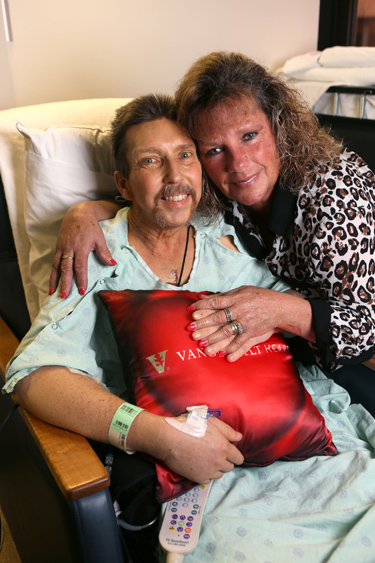On April 7, a 48-year-old man from Bethpage, Tennessee, became the 300th person to receive a left ventricular assist device (LVAD) at Vanderbilt Heart and Vascular Institute (VHVI).

An LVAD is an implantable mechanical device that helps circulate blood throughout the body. It is designed to supplement the pumping function of the heart for patients whose hearts are too weak to pump blood adequately on their own.
Tracy Rippy is the 300th patient to receive an LVAD since VHVI implanted its first in 2009.
Rippy, who suffered from heart failure, was transferred to Vanderbilt from another medical center for severe left ventricular dysfunction, persistent atrial fibrillation, and management of cardiogenic shock with multi-organ dysfunction.
“I was at my lowest point because my kidneys and liver had shut down. I asked Dr. (Mary) Keebler if I had waited one more day, would I be here, and she looked at me and said ‘no,’” Rippy said from his room on the seventh floor of Vanderbilt University Hospital.
Vanderbilt Heart’s LVAD program has steadily grown from one LVAD implant in 2009 to a record 92 devices in 2014. Ten patients have received the device so far in 2016.
“The growth of the program is a real testament to Vanderbilt’s people. In a short period of time, the VAD team was able to adapt, overcome barriers and deliver complex care for the people in this region, which speaks to something truly unique and extraordinary about the team,” said Ashish Shah, M.D., professor of Cardiac Surgery and Surgical Director, Vanderbilt Heart Transplant and Mechanical Circulatory Support.
“Importantly, it speaks to what can be uniquely accomplished at Vanderbilt: there is a capacity to do the difficult things and solve tough problems for desperately sick people.”
Vanderbilt Heart offers LVADs as both destination therapy, a permanent solution for patients who are not candidates for heart transplantation, and as bridge-to-transplant, designed for patients like Rippy who hope to eventually receive a donor heart.
A team of 20 caregivers, including cardiologists, cardiac surgeons, VAD coordinators and program administrators, collaborate to evaluate patients and shepherd them through the procedure, which can require a two-week hospital stay.
The team has evaluated 150 patients annually for the last three years, said ventricular assist device program coordinator Steve Janson.
As part of its ongoing commitment to provide excellent care for heart failure patients in Tennessee and the Southeast, VHVI was the first center in the state to implant the HeartMate 3, a novel LVAD from St. Jude Medical.
Vanderbilt Heart is currently one of 60 select centers chosen to evaluate the HeartMate 3 as part of the MOMENTUM 3 trial, which is expected to enroll more than 1,000 patients nationwide.
VHVI is also involved in the HVAD Lateral trial, following patients who have the HeartWare LVAD that was implanted using the less-invasive thoracotomy approach, a small incision in the side of the chest.
Additionally, Vanderbilt Heart was a top enrolling center in the Thoratec PREVENT trial last year, a study that looked at implantation technique, anticoagulation regimen, pump speed and blood pressure management in hopes of assessing the incidence of pump thrombosis (blood clot) in the HeartMate II device.
“Under the direction of Mary Keebler, M.D., Matthew Danter, M.D., and former surgical director Simon Maltais, M.D., this group was able to build not just a busy clinical program, but an internationally recognized research program that is intimately concerned with asking and answering clinically important questions,” Shah said.
“It’s a unique, collaborative approach to both clinical care and research in which Cardiology and Cardiac Surgery work together.”












